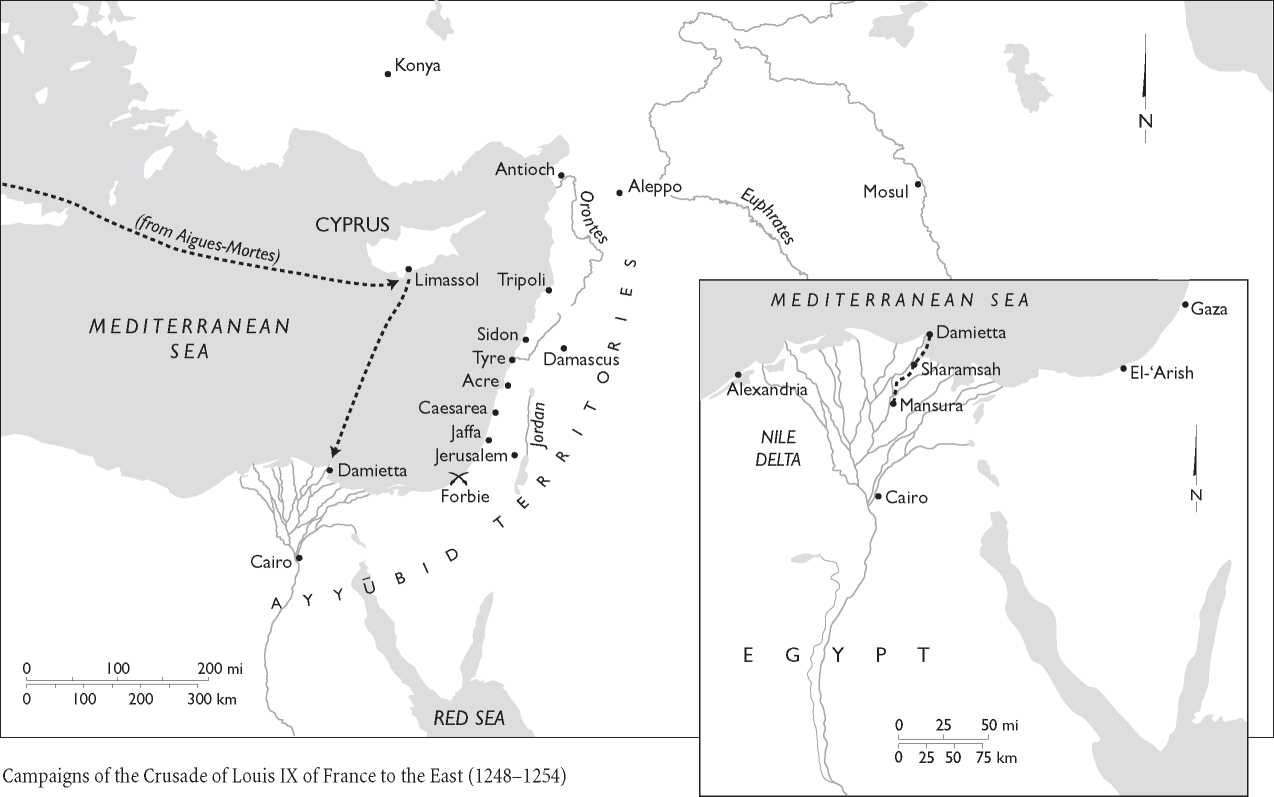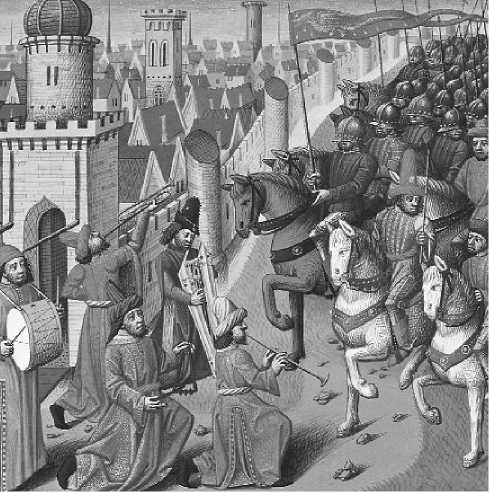The first crusade led by King Louis IX of France, which aimed to relieve the Holy Land by attacking Egypt, the main seat of Ayyubid power in the Near East; it initially met with success but ended in defeat, with most of the army, including the king, captured by the Muslims.
In December 1244 Louis IX was motivated by a number
Of personal, religious, and political factors to take the cross. Most chroniclers record that the king was seriously ill and vowed to go on crusade in response to a vision when close to death. It is probable, however, that his vow was not made simply to obtain a cure, but was motivated by a number of other concerns. The political situation in Outremer was ripe for a new crusade. In August 1244 the city of Jerusalem, which had been restored to the Christians, was sacked by the Khwarazmians, a Muslim people from central Asia that had been driven westward by the advancing Mongols and formed an alliance with al-Salih Ayyub, sultan of Egypt. On 17 October 1244 the army of the kingdom of Jerusalem was annihilated by a combined Egyptian-Khwarazmian army at La Forbie near Gaza.
Although news of the defeat did not reach Europe before the end of January 1245, it is possible that rumors about the fall of Jerusalem influenced Louis’s decision. The king was a pious man, and the crusade provided an opportunity for the secular classes to achieve a spiritual reward; he came from a family that had a dynastic tradition of crusading, which he must have wanted to maintain; his personal prestige and political reputation would be enhanced by participation in the crusade, which was regarded as an imperative for Christian princes, and Louis was undoubtedly moved by the plight of the holy places and the Christians in the East.
Pope Innocent IV also recognized the need for a new crusade to relieve Outremer and issued the crusade encyclical Afflicti corde at the Council of Lyons in July 1245. Together with the appointment of a number of crusade preachers led by Odo of Chateauroux, this papal recognition of Louis’s expedition boosted recruitment in France. Yet elsewhere enthusiasm was muted. Germany and Italy were preoccupied with the conflict between Emperor Frederick II and the pope, eastern Europe was recovering from the Mongol invasion of 1241, England was dominated by internal conflict, and a new crusade was being launched in Spain against the Muslims of the Iberian Peninsula.
Louis IX attempted to reconcile the emperor and the pope in the interests of the crusade, but without success, and tried in vain to secure peace with Henry III of England to ensure that France would not be attacked in his absence. He initiated an inquiry into injustices perpetrated throughout France in the name of the Crown and ensured that the kingdom’s administration was in good order during his absence. He raised money for the expedition by a wide range of means: he reduced his own expenditure, increased the level

Of fines imposed by courts, confiscated the property of Jews, placed impositions on the towns, and persuaded the French clergy to contribute a tenth of their ecclesiastical revenues for three years, rather than the twentieth specified by the pope in Afflicti corde. The annual royal revenues have been estimated at 250,000 livres, most of which was needed for the Crown’s normal expenditure, but Louis spent at least 1.5 million livres during the crusade, of which some 950,000 livres were contributed by the church and 274,000 livres by the towns. In 1246 Louis contracted for a fleet of thirty-six ships from Genoa and Marseilles to transport the crusaders and began stockpiling food and wine on Cyprus; meanwhile, development of the port of Aigues-Mortes on the Mediterranean coast of France was speeded up to provide a departure point for the crusaders.
Louis’s commitment to the expedition and the failure of any other rulers to join it made him its undisputed secular leader. In 1248 Odo of Chateauroux was appointed legate to accompany the crusade. On 25 August Louis sailed from Aigues-Mortes with an army that probably numbered around 2,500-2,800 knights, 5,000 squires and sergeants, over 10,000 foot soldiers, and almost 5,000 crossbowmen. The assembly point for the crusade was Cyprus. The island’s abundant resources enabled it to support the crusade army during the winter, and its position allowed an attack to be launched toward either Egypt or Palestine. In May 1249 the fleet set sail, and on 4 June it reached the Egyptian coast off Damietta (mod. Dumayat). The army landed almost unopposed, and the Ayyubid forces abandoned Damietta to the Christians.
In November the army began to march up the Nile toward Cairo, the Ayyubid capital, having rejected the alternative proposal to attack the port of Alexandria. Adverse weather conditions impeded the army’s progress, and it took a month to reach the bank of a Nile tributary opposite the town of Mansurah (mod. El-Mansura). The crusaders were unable to cross, and it was only in February 1250 that a local inhabitant informed them of the existence of a ford. Louis ordered the army to cross and regroup on the far bank before any further advance was made.
On 24 November the Ayyubid sultan had died, but his death had been concealed while his son, Turan-Shah, traveled from Iraq. The Ayyubid army was held together by the sultan’s widow, Shajar-al-Durr, and Fakhr-al-Din, a senior Egyptian emir who had previously negotiated with Frederick II on the sultan’s behalf, but if it was defeated the road to Cairo would be clear. The Christian vanguard, which

Conquest of Damietta by Louis IX of France, from the Speculum Majus, fifteenth century. (Archivo Iconograpfico, S. A./Corbis)
Included the king’s brother, Count Robert of Artois, ignored Louis’s directive to wait for the rest of the army and attacked the Ayyubid camp. The Muslims were caught unawares, and many were massacred. Robert and the vanguard then attacked Mansurah, but the Ayyubid forces regrouped between the town and the river and cut them off from the main army. The crusaders became dispersed in the streets of the town and were attacked from the rooftops. Unable to escape and without hope of rescue, they were slaughtered.
The rest of the crusader army crossed the Nile and after a daylong battle scored an important victory, but its offensive capabilities were seriously affected by the loss of the vanguard, which had included the army’s elite knights and the experienced Templars. The Ayyubids recovered their position and subjected the crusaders to constant attack. The two sides entered into negotiations, which involved the exchange of Damietta for Jerusalem; however, the possibility of an agreement evaporated when the Ayyubids demanded that Louis surrender himself as surety for the deliverance of Damietta. The Ayyubids tipped the balance in their favor when they transported galleys overland and launched them on the Nile between the Christian army and Damietta to intercept supplies being carried upriver from the coast.
Without fresh provisions and ravaged by disease, Louis’s weakened army was obliged to retreat. On 5 April 1250 it began its march, but its progress was slowed by the great number of sick and wounded, who now included the king. Continually attacked by the Ayyubid army, the rearguard halted at Sharamsah while the majority of the army reached Fariskur, a day’s march from Damietta. Philip of Montfort tried to negotiate a new truce, but his efforts were frustrated when a French sergeant called on the crusaders to surrender, pretending to repeat an order from the king. As a result, the crusaders laid down their arms, and the Ayyubids refused any further discussion of terms. A massacre ensued and the defeat was complete. The king and most of his nobles were imprisoned and many of the soldiers killed. Only a small number, which included the legate, reached Damietta.
Louis negotiated the release of the army in return for the surrender of Damietta and a payment of 400,000 livres. A ten-year truce was agreed on. The treaty, originally concluded with Turan-Shah, was confirmed by the Mamluk emirs who had assassinated the new sultan on 2 May, overthrowing the Ayyubid regime. Louis was released on 6 May. Damietta was handed over, and the king was rigorous in his efforts to ensure that the ransom was paid in full. The new Mamluk government, however, broke its promises, slaughtering the Christians who remained in Damietta and burning the crusaders’ provisions and war machines.
Louis sailed to Outremer with the remnants of his army, intending to refit the fleet and await the arrival of the rest of the prisoners and equipment before returning to France. The failure of the truce, however, prompted Louis to remain in the East. In a letter to his subjects, he explained that he needed to stay in order to secure the release of the captives and to ensure that Outremer was not lost to Christendom, and he asked for warriors to join him and for money to be sent.
Many of the French barons now returned to France, but Louis turned his attention to refortifying the towns and castles in the kingdom of Jerusalem. While still in Acre (mod. ‘Akko, Israel) Louis began to build a defensive wall around the suburb of Montmusart. In March 1251 he moved to Caesarea (mod. Har Qesari, Israel), where he spent over a year reinforcing the town. In May 1252 he moved to Jaffa (mod. Tel Aviv-Yafo, Israel), which he refortified, and in 1253 he rebuilt Sidon (mod. Saida, Lebanon). Louis also reconciled Prince Bohemund VI of Antioch with his mother, the regent, and established peace between Antioch and Cilicia. In 1252 he concluded a peace with Egypt; its terms included the return of almost all the Christian captives and the waiver of the remaining 200,000 livres of the ransom. Little else of lasting value was gained from this truce, however, because it was superseded by a subsequent treaty between the Mamluks and the Ayyubids of Damascus and Aleppo that was directed against the Christians. In 1254 Louis concluded a truce with the Ayyubid prince al-Nasir, to last for two years, six months, and forty days. This provided a sufficient safeguard for Louis to embark for France (24 April), where his mother, the regent, had died.
During his stay in the East, Louis had failed to recapture Jerusalem or score a military success, but he had refortified Outremer, secured peace among the Christians, and obtained a truce with the Muslims. He also left an important legacy in the form of a force of French knights, crossbowmen, and sergeants who contributed to the defense of the kingdom until the fall of Acre in 1291.
-Linda Goldsmith
Bibliography
Jordan, William C., Louis IX and the Challenge of the Crusade (Princeton, NJ: Princeton University Press, 1979).
-, Ideology and Royal Power in Medieval France:
Kingship, Crusades and the Jews (Aldershot, UK: Variorum, 2001).
Richard, Jean, “La politique orientale de saint Louis: La croisade de 1248,” in Septieme centenaire de la mort de Saint Louis: Actes des Colloques de Royaumont et de Paris (21-27 mai 1970), ed. Louis Carolus-Barre (Paris: Les Belles Lettres, 1976), pp. 197-207.
-, Saint Louis: Crusader King of France (Cambridge:
Cambridge University Press, 1992).
-. The Crusades c. 1071-c. 1291 (Cambridge: Cambridge
University Press, 1999).
Strayer, Joseph R., “The Crusades of Louis IX,” in A History of the Crusades, ed. Kenneth M. Setton, 6 vols. (Madison: University of Wisconsin Press, 1969-1989), 2:487-518.




 World History
World History









